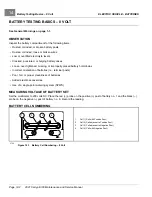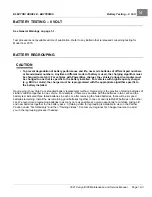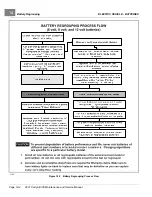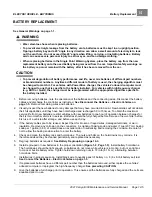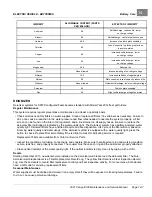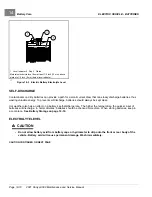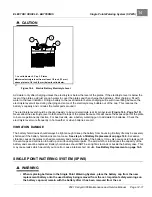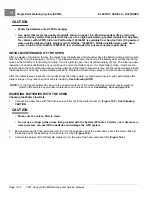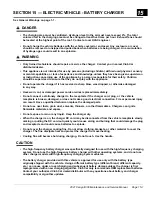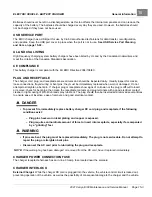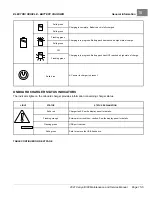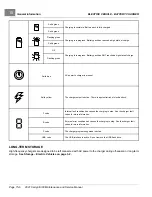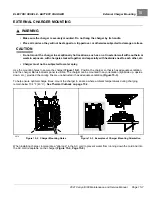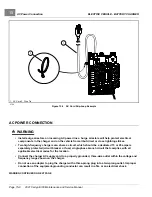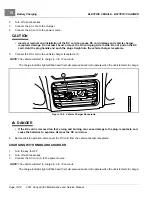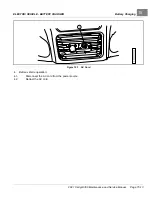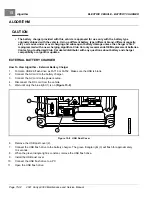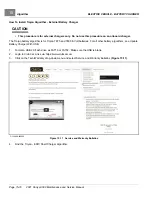
15
General Information
ELECTRIC VEHICLE - BATTERY CHARGER
GENERAL INFORMATION
NOTE:
This charger has no internals to service or repair. It only has a few external repairs that can be performed.
If an internal component needs repair, the charger must be replaced.
Because the charger has a storage charge feature that automatically checks and recharges the batteries as
necessary, the charger can remain plugged to the vehicle throughout the storage period.
Key Differences between ERIC Chargers and PowerDrive Chargers
• Programmable in the field instead of changing onboard computer (OBC).
• Ability to fully update software via USB flash drive or laptop computer instead of changing OBC.
• DV/DT charge termination instead of Amp-Hour Returned charge termination.
• Communication Display Module (CDM) is not used. Only a CDT is needed for data.
• The CDT will remain ON when the charger is connected.
• Only PD+ 8-volt batteries are approved for use with this high-frequency charging system at this time. Other
batteries have not been approved. When other batteries are approved, the charger can be updated with the
appropriate algorithm using the USB port.
This section includes information, troubleshooting and service procedures pertaining to the external high-frequency
battery charger (model number IC0650-048-CC). Do not attempt to service a battery charger that has not been properly
identified. If a charger cannot be properly identified, contact your local Club Car dealer or distributor.
COV-1481
Figure 15-1
High-Frequency Battery Charger – External
The high-frequency battery charger is automatic and has no external controls. It functions as an integral part of the
vehicles' electrical system and will not work with other electric vehicles. The charger is programmed with a specific
charge algorithm that is appropriate to the specific battery type used in the vehicle. When the charger is connected,
there is a 2 to 5 second delay before charging begins. When the AC cord is connected, the charger performs a start-up
self-test (all three charger status indicators on the front of the charger flash ON at the same time).
The charger supplied with the electric vehicle resolves the most common problems associated with battery charging.
The charger utilizes sophisticated charge termination criterion to shut off automatically, preventing the possibility of
either undercharging or overcharging. The charger accomplishes this by monitoring battery voltage, charge current,
charge time and using strict dV/dt termination criterion.
Page 15-2
2021 Carryall 300 Maintenance and Service Manual
Summary of Contents for Carryall 300 2021
Page 2: ......
Page 16: ......
Page 551: ...80 2018 by Kohler Co All rights reserved KohlerEngines com 17 690 15 Rev...
Page 565: ...GASOLINE ENGINE HARNESS Wiring Diagrams Gasoline Engine Harness 26...
Page 566: ...Page intentionally left blank...
Page 567: ...GASOLINE KEY START MAIN HARNESS Wiring Diagrams Gasoline Key Start Main Harness 26...
Page 568: ...Page intentionally left blank...
Page 569: ...GASOLINE PEDAL START MAIN HARNESS Wiring Diagrams Gasoline Pedal Start Main Harness 26...
Page 570: ...Page intentionally left blank...
Page 571: ...GASOLINE INSTRUMENT PANEL HARNESS Wiring Diagrams Gasoline Instrument Panel Harness 26...
Page 572: ...Page intentionally left blank...
Page 573: ...GASOLINE FNR HARNESS Wiring Diagrams Gasoline FNR Harness 26...
Page 574: ...Page intentionally left blank...
Page 575: ...ELECTRIC MAIN HARNESS Wiring Diagrams Electric Main Harness 26...
Page 576: ...Page intentionally left blank...
Page 577: ...ELECTRIC INSTRUMENT PANEL HARNESS Wiring Diagrams Electric Instrument Panel Harness 26...
Page 578: ...Page intentionally left blank...
Page 579: ...ELECTRIC ACCESSORIES HARNESS Wiring Diagrams Electric Accessories Harness 26...
Page 580: ...Page intentionally left blank...
Page 588: ...NOTES...
Page 589: ...NOTES...
Page 590: ...NOTES...
Page 591: ...NOTES...
Page 592: ...NOTES...
Page 593: ...NOTES...
Page 594: ...NOTES...
Page 595: ......
Page 596: ......

